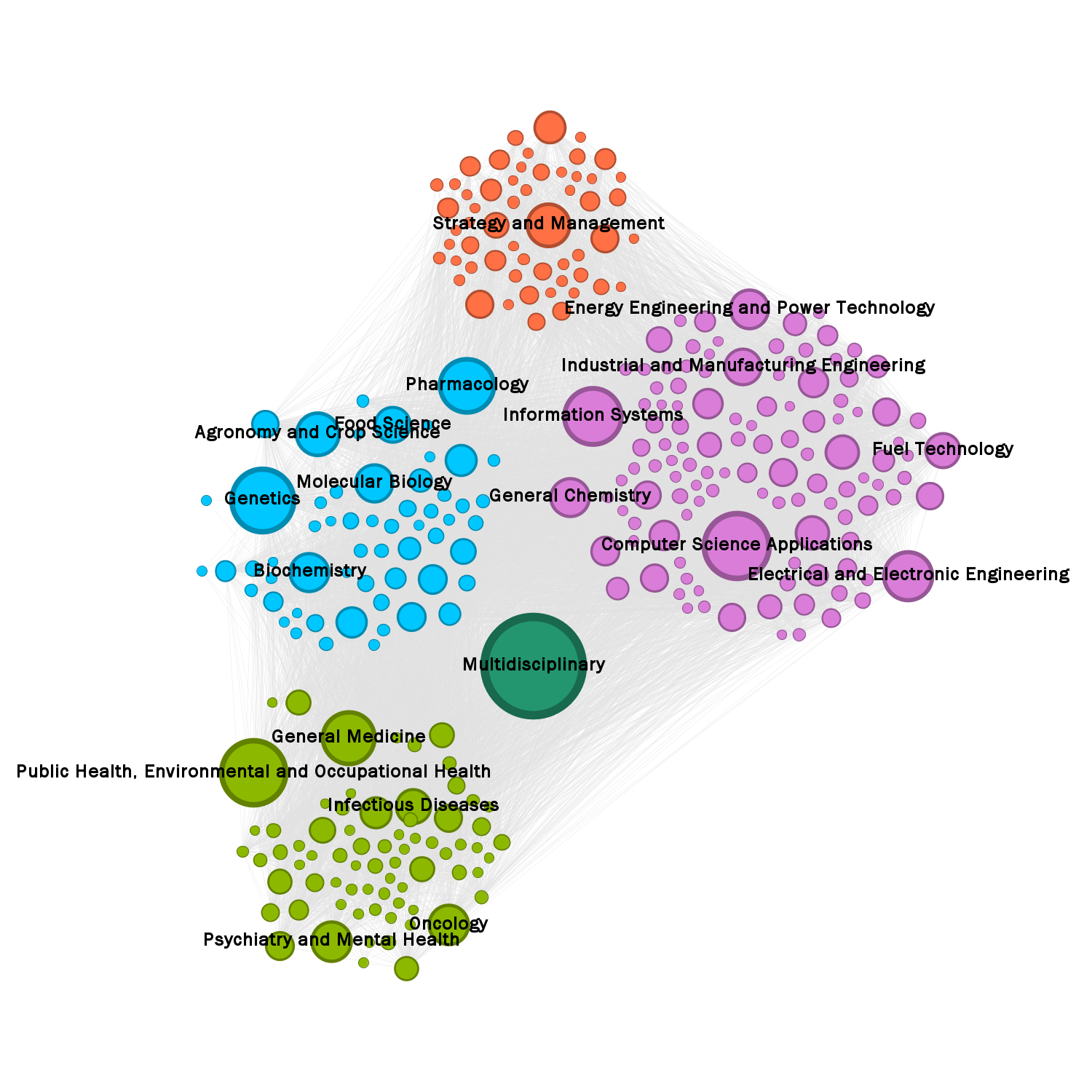

Sergio Hernández Rocha, Juan David Ardila Suárez, Víctor Fonseca, Yessika Martínez, Julián D. Cortés
C0008
Oct 2023
Abstract
Research collaboration between the private sector and academia is one of the core aspects to solve complex problems through science, technology and innovation. Despite this societal relevance, we still lack insights about the research topics in which both sectors intersect their agendas, particularly in middle-low-income regions. To shed light on this question, Julián D. Cortés, chaired professor at Woxsen University, applied bibliometric techniques to a sample of 13,000+ research articles and 500,000+ references to determine the research fronts in which research institutions based in Latin America and the Caribbean collaborated with knowledge-intensive companies. Fields of strategic importance for both sectors were computer science applications, genetics, health, public health, environmental and occupational health and strategy and management. Also, the author identified several unexplored research fronts, particularly in health (e.g. care planning) and the social sciences and humanities (e.g. demography).
The relevance of academia and private sector collaboration
Academia requires support from other sectors to address society’s complex problems. One of those sectors is the private sector. Private sector and academia have collaborated closely for the advancement of new knowledge and the transformation of concepts. Through cooperation and strategic partnerships, both parties support each other to achieve their goals. The private sector provides funding, resources, and technology, while academia brings its research expertise and theoretical approach. This combination results in a better understanding of problems and innovative solutions, as well as the identification of new research areas. In the private sector realm, these collaborations can create new opportunities and guide companies according to market and societal demands.
Cooperation between the private sector and research institutions aims to develop innovative solutions that meet market demands. This cooperation can vary in nature depending on the economic sector and the proposed research. In addition to financial resources, it is important to consider the transfer of technology and knowledge between both parties; companies can benefit from the expertise of research institutions in the development of their products, while institutions can tackle new challenges through the knowledge and infrastructure provided by companies. This cooperation enables the generation of more effective solutions and the addressing of specific challenges that are not solely addressed within academia. Thus, identifying industry-research usual and potential collaboration fields provides an opportunity for research, innovation, scientific and socioeconomic progress.
In addition, the Sustainable Development Goal 9 in its 5 indicator highlights the importance of enhancing scientific research and technological capacity to drive innovation and development. Research on the cooperation between industry and academia can lead to best practices and public policies that strengthen these partnerships and harness the potential of research and technology to address social and environmental challenges. These investigations also have implications for other SDGs, such as health, affordable energy, and climate action, as the collaboration between industry and academia can be a crucial tool in tackling these global challenges within the framework of the 2030 Agenda for Sustainable Development.
Identifying mutual research interests
One way to identify industry-research collaborations is to search for published articles in which authors from recognized academic institutions and industry companies have participated. Afterwards, research fields, interconnections and clustering can be spotted using bibliometric analysis tools to find collaboration focuses and opportunities. This approach was conducted by Julián D. Cortés, Woxsen University professor and holder of the Chair - Vijay Govindarajan Professor of Strategy and Innovation. The study entitled: “Industry-research fronts – Private sector collaboration with research institutions in Latin America and the Caribbean” was published in the prestigious Journal of Information Science. The aforementioned study focuses on Latin America, a developing region which lacks specific insights into its academic and industry collaboration and their mutual research areas of interests.
In the analyzed study, the author of the study sourced the data from the bibliographic database Scopus. More than 13,000+ research articles in which researchers from universities and firms in Latin America and the Caribbean between 1996 and 2021 were analyzed.
In this study, the author has employed bibliometric coupling to analyze the links between research papers and established literature clusters. This approach enabled the study to go beyond individual research papers and uncover more significant trends and areas of research. Bibliometric coupling is a powerful method for discovering research patterns. It helps identify similarities between two articles based on their shared references to a joint research paper.
For example, if one research paper focuses on microfinance and gender, and another article discusses women's career opportunities in Malaysian SME accounting firms, both of which cite works by Judith Butler, a bibliographic coupling analysis would establish a connection between them. We can also determine the strength of the relationship based on the number of commonly referred articles.
The author created a network to understand their connections and the emergence of new topics. This approach provides valuable insights into the research landscape, helping identify trends, patterns, and possible research gaps. These findings can benefit policymakers, researchers, and other stakeholders in shaping research agendas, identifying emerging areas of interest, and promoting interdisciplinary collaborations. The level of analysis is quite refined, unveiling the relationships between over 330 research fields and five areas: physical sciences, health sciences, life sciences, social sciences and the humanities, and multidisciplinary. By analyzing the connections between research papers and literature clusters, it is possible to better understand the research landscape and contribute to evidence-based decision-making in academia and policy domains. The figure below shows the bibliographic coupling results as a network chart. The labeled nodes (circles) are the most strategic for each research area.

Physical science had the most active role, whereas the least active role went to social sciences and humanities. Among the various research areas represented in the network, physical science was the most prominent, comprising almost 40% of the total nodes. This area includes fields such as computer science applications, information systems, electrical and electronic engineering, energy engineering, and power technology.
The nodes that belonged to health sciences accounted for a total of 23% of the nodes. Public health, environmental and occupational health, and general medicine are among the research-fields that can be found in this area. In the field of life sciences, which constitutes approximately 19% of the nodes, there are several research fields available including genetics, pharmacology, and agronomy and crop science. When it comes to social sciences and humanities, which make up roughly 18% of all fields, there are a variety of disciplines to choose from including strategy and management, geography, planning and development, and economics and econometrics.
On the other hand, unexplored research fronts opportunities for LAC industry-research institutions were also found, particularly in health and, social sciences and humanities. Regarding health sciences, these fields include emergency medicine, pathophysiology and respiratory care, among others; while amidst social sciences and humanities, we found demography, gender studies, classics, religious studies and, life-span and life-course studies. Lastly, the field of logic in physical sciences was also identified as an unexplored opportunity.
Conclusion
The collaboration between the private sector and research institutions holds great potential for driving innovation, addressing societal challenges, and achieving the Sustainable Development Goals (SDGs). This white paper has highlighted the importance of industryacademia partnerships, emphasizing the mutual benefits that arise from knowledge and technology transfer between the two sectors.
By employing bibliometric analysis, this approach provided valuable insights into the research landscape, identifying trends, patterns, and potential research gaps. This approach allows to go beyond individual research papers and uncover significant connections and clusters within the literature. The findings from the analysis can inform policymakers, researchers, and stakeholders in shaping research agendas, promoting interdisciplinary collaborations, and making evidence-based decisions.
Overall, fostering collaboration between the private sector and research institutions is crucial for promoting innovation, addressing global challenges, and advancing sustainable development. By leveraging the strengths of both sectors, it is possible to create a positive impact on society, the economy, and the environment, ultimately leading to a brighter future for all.
References
Cortés, J. D. (2023). Industry-research fronts – Private sector collaboration with research institutions in Latin America and the Caribbean. Journal of Information Science, In press, 016555152211317. https://doi.org/10.1177/01655515221131796